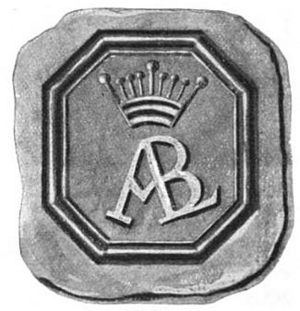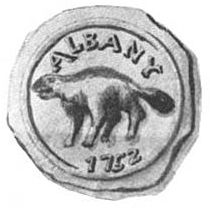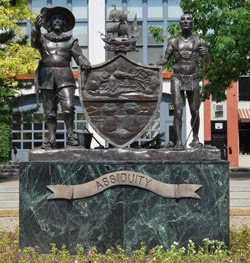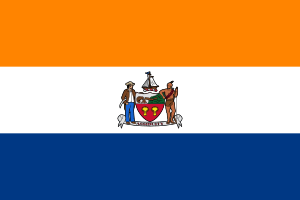Coat of arms of Albany, New York facts for kids
Quick facts for kids Coat of arms of Albany, New York |
|
|---|---|
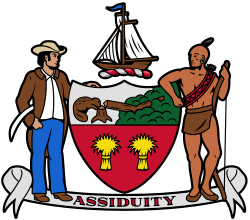 |
|
| Armiger | Civic |
| Adopted | 1789 |
| Crest | A sloop with three sails and a blue flag |
| Torse | Argent and gules |
| Blazon | Party per fess argent and gules:
|
| Supporters | A European farmer on the left and an American Indian on the right |
| Motto | Assiduity |
| Use | Seal of Albany, Flag of Albany |
The coat of arms of Albany, New York, is a special symbol that represents the city of Albany. Albany is the capital city of New York State. You usually see this symbol on the city's official seal or on its flag. The current design was chosen in 1789. Before this, the symbols were much simpler, sometimes just letters or a drawing of a beaver.
The coat of arms includes symbols that show Albany's past. These include farming and the fur trade. It is held up by a farmer and a Native American. A sloop (a type of boat) is at the top. The whole design shows "symbols of hard work and its rewards for people and animals on land and sea."
Contents
History of Albany's Symbols
Albany started as a Dutch fur-trading post in 1624. It was called Fort Orange. A village grew around it, named Beverwijck. This name means "Beaver District" in English. In 1652, it became an official village.
In 1664, the English took over the area. Beverwyck was renamed Albany. This honored the Duke of York and Duke of Albany, who later became King James II.
Early City Seals and Designs
When Albany became a city in 1686, it was allowed to have its own seal. This seal would be used for all official city business. The city could also change its seal whenever it wanted.
The first known seal was used in 1686. It was on a deed signed by Albany's first mayor, Pieter Schuyler. The seal was made of red wax. It showed an octagon with the letters ALB in the middle. A crown was on top (see Figure 1). The letters probably stood for Albany. The meaning of the crown is not known.
Before 1752, the seal changed. It showed a beaver in the center. The letters "ALB" were above it. In 1752, this seal was replaced. The new seal had "Albany" above the beaver and the year "1752" below it (see Figure 2).
The beaver was important. It honored Albany's past as a major fur trading port. One historian said the beaver on the seal looked "more like a drowned cat" than a real beaver. In 1755, the very first seal (Figure 1) was used again for licensing businesses. So, for a short time, Albany had two seals. But the beaver seal soon became the only one used.
The current coat of arms was adopted in 1789. It first appeared on a city map in 1790. An updated map from 1794 also showed it. These early versions had more beavers and trees. There is no clear reason why the city changed from the beaver seal to the coat of arms. The coat of arms itself was not officially recorded as being adopted.
Understanding the Coat of Arms
The current coat of arms has many traditional heraldic parts. These are special symbols used in coats of arms.
The Shield's Meaning
The main part is the shield. It is split horizontally into two halves. The bottom half is red, and the top half is silver.
- The lower red half shows two golden bundles of wheat. This represents Albany's history in farming.
- The upper silver half shows a beaver gnawing on a fallen tree stump. This part reminds us of Beverwyck's fur trade. The fur trade was very important for Albany's early growth.
Supporters and Motto
On each side of the shield, there is a person called a supporter.
- The man on the left is a European farmer. He wears simple clothes and holds the shield with his left hand. A sickle, a farming tool, hangs from his waist. This shows Albany's farming past.
- The man on the right is an American Indian. He wears a loincloth and moccasins. He holds the shield with his right hand and a bow over his left shoulder.
These two men together show the cooperation between early European settlers and Native Americans. The city would not have grown without the fur trade with the Native Americans.
The men stand on a scroll. This scroll displays the motto Assiduity. This word means "working with constant and careful attention."
The Crest and Its Symbolism
Above the shield is the crest. It is a sloop (a type of sailboat) with its sails full. It faces left. This symbol shows Albany's importance as a port. It was at the top of the Hudson River where sloops could travel.
The entire coat of arms represents "symbols of hard work and its rewards for people and animals on land and sea." In 1886, it was believed that only New York City and Albany had coats of arms held up by supporters.
How the Coat of Arms is Used
Albany's coat of arms is most famous for being on the city seal and the city flag.
City Seal and Flag
The city seal shows the coat of arms inside a white circle. The words "The Seal of the City of Albany" are written above it.
The city flag has three horizontal stripes: orange, white, and blue. It was adopted in 1909. This was part of the 300-year celebration of Henry Hudson discovering the Hudson River. The flag's design comes from the Prince's Flag. This was a flag flown by the Dutch East India Company (EIC). Henry Hudson sailed for this company in 1609. The EIC flag also had three colors and its company logo where Albany's coat of arms is now.
The Prince's Flag was orange, white, and blue. The orange color came from the coat of arms of the Prince of Orange, William the Silent. Albany chose this historic flag as its base. In 1916, some people wanted to change the flag's colors to red, white, and blue. This was during World War I to show patriotism. But Mayor Joseph Stevens stopped this change.
Public Art
A life-size sculpture of the coat of arms was made in 1986. It was created by artist Hy Rosen. He was a political cartoonist for the Times Union newspaper. Rosen added some extra details to the statue. He included farm tools to highlight the city's farming and trading past. The farmer supporter also looks a bit like an explorer, like Henry Hudson.
The statue was placed in Tricentennial Park. It is across Broadway from the old Union Station. The statue still stands there today.
See also
 In Spanish: Escudo de Albany para niños
In Spanish: Escudo de Albany para niños


